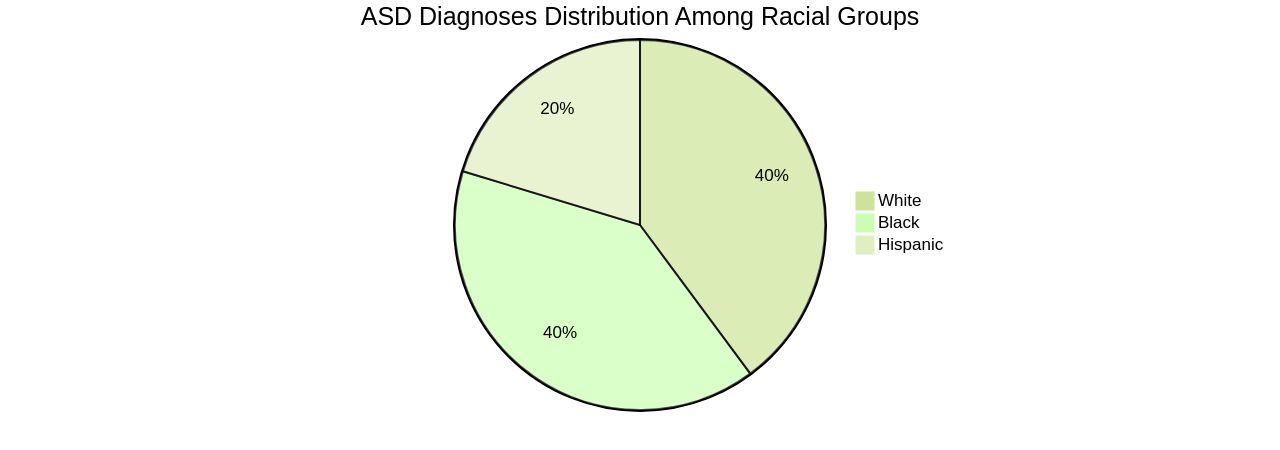Introduction
Understanding Autism Spectrum Disorder (ASD) involves recognizing its profound impact on individuals throughout their lives. ASD is not a one-size-fits-all condition; it manifests uniquely across the spectrum, with varying degrees of social, communicative, and behavioral challenges. As we delve deeper into the experiences of autistic individuals, particularly adults, we uncover their psychological and societal hurdles.
A staggering 10-20% of children diagnosed with ASD before the age of five manage to live independently in adulthood. This highlights the necessity for early diagnosis and intervention, which can lead to optimal outcomes for those affected. Research indicates that ASD is influenced by both genetic and environmental factors, with Naviaux noting the inseparable link between behavior and metabolism.
Understanding these connections is key to developing new insights into ASD. Moreover, service dogs have become a beacon of support, not only for autistic children but also for entire families. These canines are more than pets; they are integral to fostering resilience, enhancing social connections, and reducing stigma.
Statistics reveal males are four times more likely to be diagnosed with ASD, comprising 81% of the autistic population. Additionally, 31% of diagnosed children fall into the intellectual disability range, with another 25% on the borderline, and 44% in the average to above-average range. Such data underscore the diversity within the autism community and emphasize the importance of tailored support and understanding for every individual on the spectrum.
What is Autistic Spectrum Disorder?
Understanding Autism Spectrum Disorder (ASD) involves recognizing its profound impact on individuals throughout their lives. ASD is not a one-size-fits-all condition; it manifests uniquely across the spectrum, with varying degrees of social, communicative, and behavioral challenges. As we delve deeper into the experiences of autistic individuals, particularly adults, we uncover their psychological and societal hurdles.
A staggering 10-20% of children diagnosed with ASD before the age of five manage to live independently in adulthood. This highlights the necessity for early diagnosis and intervention, which can lead to optimal outcomes for those affected. Research indicates that ASD is influenced by both genetic and environmental factors, with Naviaux noting the inseparable link between behavior and metabolism.
Understanding these connections is key to developing new insights into ASD. Moreover, service dogs have become a beacon of support, not only for autistic children but also for entire families. These canines are more than pets; they are integral to fostering resilience, enhancing social connections, and reducing stigma.
Statistics reveal males are four times more likely to be diagnosed with ASD, comprising 81% of the autistic population. Additionally, 31% of diagnosed children fall into the intellectual disability range, with another 25% on the borderline, and 44% in the average to above-average range. Such data underscore the diversity within the autism community and emphasize the importance of tailored support and understanding for every individual on the spectrum.

Definition of Autistic Spectrum Disorder
The study of autism spectrum disorder (ASD) is continually evolving, and recent research has begun to look beyond the individual to understand how ASD affects family dynamics, particularly when service dogs are introduced into the home. In a groundbreaking study published in Frontiers of Psychiatry by Dr. Maggie O'Haire's lab, the introduction of a service dog to a family with an autistic child revealed that these animals provide more than just assistance to the child—they become integral to the family's overall resilience.
By enhancing emotional well-being, improving interactions, and bringing joy, service dogs foster a supportive environment that benefits all family members, not just the child with ASD. In terms of the animals involved in these therapeutic interactions, a study assessing the welfare of therapy dogs during sessions with autistic children found no significant changes in stress biomarkers such as salivary cortisol, alpha amylase, and oxytocin.
This suggests that these therapy dogs do not experience heightened stress while working, which is a vital consideration for the ethical implementation of canine-assisted therapy. As research continues, it becomes increasingly clear that the human-animal bond is mutually beneficial, and the positive impacts of these relationships extend well beyond the therapy sessions.
The prevalence of ASD in children has wide-reaching implications for families and society. In Australia, for example, males are diagnosed with autism more frequently than females, with a ratio of approximately 3:1. This rising prevalence underscores the need for continued research, inclusive policies, and person-centered support services to cater to the unique needs of those on the autism spectrum and their families. By focusing on early identification and intervention, we can ensure better outcomes and a more inclusive future for individuals with ASD and their communities.
Epidemiology of Autistic Spectrum Disorder
Autism Spectrum Disorder (ASD) is an increasingly recognized neurodevelopmental condition, now estimated to affect 1 in 36 children in the United States, a significant rise from the 1 in 125 recorded in 2004. This surge reflects wider identification across different racial groups, with current reports showing more diagnoses among White and Black children than Hispanic children. However, challenges such as stigma, healthcare access limitations due to socio-economic factors, and language barriers persist, leading to delayed diagnosis for children of color.
Boys are diagnosed with autism approximately four times more frequently than girls, although research suggests girls may exhibit autism differently, leading to potential underdiagnosis. The impact of autism stretches beyond childhood, with educational data revealing disparities in classroom integration and graduation outcomes. For instance, in California, autism was identified in 17.28% of special education students, compared to just 5.76% in Montana.
Nationwide, boys represented more than 80% of students with autism, with around 40% spending the majority of their school day in regular classrooms and approximately 72% earning a regular high school diploma. The growing awareness of autism has improved public acceptance, yet the reasons behind the increasing rates remain multifaceted, with factors such as better screening, environmental influences, and various prenatal conditions contributing to the prevalence. This complex landscape underscores the need for continued research and advocacy to support individuals with autism and their families.

Causes of Autistic Spectrum Disorder
Autism Spectrum Disorder (ASD) is a complex condition that, according to current research, stems from an intricate blend of genetic and environmental factors. A study led by Dr. Daniel Geschwind at UCLA highlights the importance of examining rare inherited variations, particularly in families with multiple children affected by autism. This research uncovered seven genes that may increase the likelihood of ASD, a significant finding given the size of the study cohort.
Despite the discovery of these genes, the overall genetic landscape of autism remains polygenic, with thousands of small-effect genetic variants contributing to the condition, as demonstrated by Genome-Wide Association studies. Notably, autism's genetic risk factors are shared with other psychiatric conditions such as ADHD and depression, and are even positively correlated with intelligence and educational attainment. This shared genetic architecture points to the complexity of ASD's etiology, as echoed by the news that both synaesthesia and autism are influenced by numerous genes that can vary between families.
Moreover, the presence of psychiatric disorders in parents has been linked to a heightened risk of ASD in offspring, suggesting that genetic susceptibility to mental health conditions could be a contributing factor. This genetic complexity is further complicated by environmental influences. However, it is crucial to dispel myths: ASD is not caused by vaccines, parenting styles, or nutrition.
Instead, researchers are focusing on identifying specific genetic variants and understanding how a combination of these variants could trigger the development of autism. Brain scans have revealed structural differences in individuals with ASD, yet the precise mechanisms and triggers remain under investigation. Understanding the genetic and environmental interplay is essential for identifying children at high risk for ASD and for informing public health discussions on the condition.
Evaluation and Diagnosis of Autistic Spectrum Disorder
Navigating the complexities of Autism Spectrum Disorder (ASD) diagnosis can be a deeply impactful journey for both children and their families. With an increasing number of children being diagnosed—1 in 60 worldwide according to the WHO—the need for a streamlined diagnostic process is more critical than ever. A comprehensive assessment by a multidisciplinary team of experts, including psychologists, pediatricians, and speech therapists, is the cornerstone of identifying ASD.
This process not only sheds light on the child's unique needs but also sets the stage for early intervention, which is pivotal for enhancing the child's development and family's quality of life. However, the journey doesn't end with diagnosis. Families often face challenges such as long waiting times, miscommunication with professionals, and a lack of clear information, leading to dissatisfaction.
The current study sheds light on the experiences of 18 parents whose children were diagnosed with ASD, highlighting the emotional relief and increased sense of understanding that a timely diagnosis can bring. Meanwhile, research on the impact of canine-assisted therapy shows that dogs can provide valuable support to children with ASD, helping to reduce stress and foster social connections without compromising the animals' welfare. These findings underscore the importance of early and accurate diagnosis, the potential of therapeutic interventions, and the need for ongoing support to navigate the lifelong journey of ASD.
Conclusion
In conclusion, Autism Spectrum Disorder (ASD) is a complex condition that manifests uniquely across the spectrum. Early diagnosis and intervention are crucial for optimal outcomes, highlighting the importance of understanding the genetic and environmental factors that influence ASD.
Service dogs provide invaluable support to individuals with autism and their families, fostering resilience and reducing stigma. The diversity within the autism community emphasizes the need for tailored support and understanding for every individual on the spectrum.
Disparities in classroom integration and graduation outcomes underscore the ongoing need for research and advocacy to support individuals with ASD and their families. A comprehensive assessment by a multidisciplinary team is essential for early identification and intervention, bringing emotional relief and increased understanding to families navigating the journey of ASD. Canine-assisted therapy shows promise in reducing stress and fostering social connections without compromising the welfare of therapy dogs. By recognizing the unique experiences of individuals on the autism spectrum, providing early intervention, tailored support, and embracing therapeutic interventions such as canine-assisted therapy, we can empower parents to navigate challenges and ensure the well-being of their children with Autism Spectrum Disorder.




